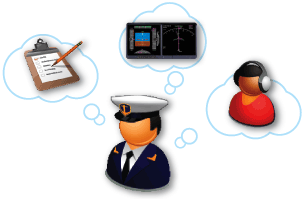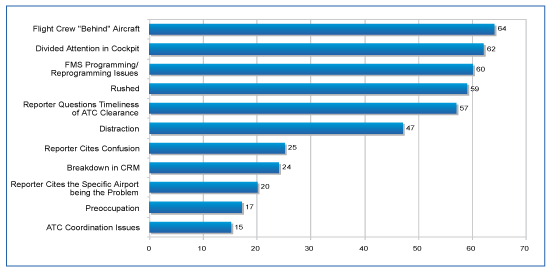 |
||||||
|
|
Number
335
|
November
2007
|
||||
|
P.O. Box 189, Moffett Field, CA 94035-0189 |
||||||
|
|
||||||
 |
||||||
|
|
Number
335
|
November
2007
|
||||
|
P.O. Box 189, Moffett Field, CA 94035-0189 |
||||||
|
|
||||||
Air Carrier In-Close Approach Change  (ICAC) Events
(ICAC) Events
At the request of NASA Ames Research Center’s Human Systems Integration Division in early 2007, ASRS performed a review of ASRS Database reports referencing In-Close Approach Changes (ICAC) – also termed Late Runway Change and Change in Runway. The ASRS Database reports spanned the time period of January 1996 to the present. Three hundred thirteen (313) relevant air carrier pilot-reported ICAC events were identified.
For the purposes of this analysis, an In-Close Approach Change Event is defined as one in which an ATC directed change from an originally assigned arrival, approach, or runway assignment results in an incident. Examples of these incidents are unstabilized approaches, track or heading deviations, speed deviations, controlled flight toward terrain (CFTT), loss of separation or airborne conflicts, wake vortex encounters, loss of aircraft control, breakdown in crew coordination, and other safety concerns cited by reporters.
As shown in Figure 1, Los Angeles International Airport (LAX), with 110 ICAC incidents, ranked as the top airport reported. Dallas/Fort Worth International Airport (DFW) ranked as the second airport with 31 incidents, and McCarran International Airport (LAS) was third with 19 reported incidents. NOTE: Various factors, including traffic volume, airport runway configuration, airspace structure, etc., will affect the reporting volume of ICAC events to ASRS and may not be directly related to actual rates of occurrence in the National Airspace System. Therefore, it cannot be assumed from the ASRS information that LAX is the worst location for these events but are rather pointing towards a broader issue of ICAC incidents in general at complex airports.
Figure 1. Airports Described in ICAC Events Reported
| Airport | Count |
|---|---|
| LAX Airport | 110 |
| DFW Airport | 31 |
| LAS Airport | 19 |
| SFO Airport | 14 |
| DEN Airport | 12 |
| Airport | Count |
|---|---|
| JFK Airport | 10 |
| ATL Airport | 9 |
| ORD Airport | 9 |
| MCO Airport | 7 |
| PHX Airport | 6 |
A typical ICAC event involves a late or changed runway assignment that may require a flight crew to make multiple changes to the autoflight system within a short period of time, often resulting in increased workload and potential data entry errors. Some examples of ICAC events from the ASRS data review highlight some safety issues involved.
ICAC Event Specifics
A report from a Falcon 20 Captain describes a flight crew “guessing game” as to which runway to program into the FMS [Flight Management System] for an arrival into LAX:
...Our ATC clearance was to descend via the CIVET arrival. ATC had not yet assigned a runway, and to load this procedure into the FMS a runway selection is required. We loaded the arrival and Runway 25R since this was the preferred runway and I had been to LAX several days earlier and this was the runway we used then. Nearing CIVET intersection, ATC informed us we would be landing Runway 24R. I instructed the First Officer to change the runway selection in the FMS to Runway 24R. He made the change and advised me so. Within about one minute, I began to verify the altitude restrictions on the arrival chart and check them in the FMS. I immediately noticed that while the runway and approach had been changed, the arrival transition between CIVET and the Runway 24R were not correct in the FMS. The transition to the Runway 25R approach was still loaded even though the Runway 24R approach was now part of the active flight plan. At about the same time, ATC stated that it looked like we were heading for Runway 25R and questioned us...While we were correcting the issue in the FMS, ATC assigned a vector to intercept the Runway 24R localizer....
While we as a crew made several mistakes during this event, there are...other areas that led to this occurrence: ATC seems to assign a runway change at a late stage on this arrival...The FMS will not allow you to load this arrival from the database unless you select a runway first (ZLA [Los Angeles Center] will not assign a runway, but will clear you to descend via the arrival, so you have to select a runway). This can lead to a situation like the above if you guess wrong. The runway assignments are handled by SOCAL [Southern California TRACON]). Reasonable advance notice will greatly reduce the possibility of something like this happening....
A late runway change at Orlando International airport (MCO) resulted in a flight crew’s failure to meet a crossing restriction.
A B737-300 First Officer describes a late runway change at Las Vegas (LAS) and difficulty reprogramming the FMC.
Course deviation. I was flying to LAS. The ATIS as copied by the Captain listed Runway 19 as the landing runway. I set up the FMS for the SKEBR arrival Runway 19. We were then cleared to descend to CLARR at 13,000 feet on the SKEBR arrival for Runway 25. When I reset the FMC for Runway 25, I ended up with overlapping information on the flight route. By the time I got it sorted out, I was past SKEBR and missed the turn to KEPEC.
ICAC Primary Problems
As part of the ASRS analysis of In-Close Approach Change events, ASRS analysts assessed the principal contributors to the incident. The ASRS analysts’ identified Flight Crew Human Performance as the most frequently occurring primary problem (197 incidents), followed by ATC Human Performance (58 incidents). Figure 2 depicts the top eight primary problem categories.
Figure 2. Top Eight Primary Problem Categories
| Primary Problem Category | Count |
|---|---|
| Flight Crew Human Performance | 197 |
| ATC Human Performance | 58 |
| Ambiguous | 29 |
| Aircraft | 11 |
| Weather | 5 |
| Environmental Factor | 3 |
| Airport | 2 |
| ATC Facility | 2 |
ICAC Contributing Factors
The ICAC report excerpts we’ve shared thus far reflect a multiplicity of factors that contributed to the incidents – flight crews “behind” the aircraft, divided attention in the cockpit, FMS programming/reprogramming issues, rushed flight crews, untimely ATC clearances, distraction, and other factors. Figure 3 shows the top eleven categories of contributing factors that were identified in the ICAC analysis as reported by pilots. These categories were not mutually exclusive, meaning that a single incident report could reference multiple contributing factors.
Figure 3. Top Eleven Contributing Factors

d
A report from a B767 flight crew flying into San Francisco (SFO) airport illustrates several of these factors, including a late runway change, FMS reprogramming issues, and a flight crew “behind” the aircraft.
Captain flying on autopilot inbound on FMS Bridge Visual Runway 28R at 6,000 feet inside of ARCHI. NORCAL [Northern California TRACON] gave us a heading to now intercept Localizer Runway 28L and descend to 5,000 feet. The Captain clicked off the autopilot as I now worked the MCP and tried to find the new localizer frequency and load the box, time permitting. Although it was VFR, there was a cloud layer at 5,000 feet, so a visual to the runway was not possible. We were kept high because ATC wanted to cross an aircraft below us from the west to Runway 28R for some reason switching us to Runway 28L. After finding and dialing in the Runway 28L localizer frequency, I saw us descending at about 1,200 fpm through 5,100 feet and I called out ‘altitude.’ The hand-flying Captain leveled off, but not before touching just below 300 feet low of 5,000 feet, at the same time overshooting slightly the Runway 28L localizer course even though the MCP was set up to both intercept the localizer and the altitude. Corrections were made quickly and the controller never mentioned it, but air carrier Y was passing in front of us and just below us. I believe this problem wouldn’t have occurred if the autopilot [had] been used throughout, and it would have been helpful if the controller wouldn’t have crossed the airplanes to opposite runways so late in the approach....
A CL65 landed on the wrong runway at DFW after a late runway change, heads-down reprogramming of the FMS, and other distractions.
We were cleared to land originally on Runway 18R, then on downwind we were changed to Runway 17C. I was inside the cockpit too much, changing the FMS, and the speed bug was broken so I was fooling with that and talking on the radio. I was the PNF, so I didn’t think to look outside until short final, then it was too late. We landed on Runway 17R and didn’t realize it until we exited the runway. The speed bug (speed reference knob) being broken was a factor (it was replaced after we landed). The runway change and me being inside too much were all factors. Also, the landing clearance wasn’t received until very short final....
ICAC Observations
As shown by review of the 313 ASRS ICAC incidents, In Close Approach Changes can present special problems for pilots and controllers in high-density airspace.
Controllers understand that pilots may experience problems with runway reassignments and are thus reluctant to issue them. But, despite their best efforts at anticipating and planning, controllers may need to issue a runway change due to the minute-to-minute changes that can occur at high-density airports and in terminal airspace during peak-period operations. Air traffic intra- or inter-facility coordination issues may further complicate the controller’s tasks.
For pilots, a change in runway assignment often involves changes to their arrival routing and transitions – further adding to their communication, traffic watch and arrival task workload in an already high-workload environment. The need to program these changes in aircraft equipped with complex FMS navigation systems compounds the problem, as waypoints, routing, transitions and runways must be quickly and accurately re-entered into the computer. The task saturation that can accompany these changes can result in data entry errors and contribute to a variety of downstream impacts including a breakdown in crew coordination, cockpit monitoring tasks, un-stabilized approaches, loss of separation, wake vortex encounters, and track, altitude and speed deviations.
| ASRS Alerts Issued in September 2007 | |
|---|---|
| Subject
of Alert |
No. of Alerts |
| Airport facility or procedure |
1 |
Chart, publication, or nav database |
1 |
| TOTAL |
2 |
| September 2007 Report Intake |
|
|---|---|
| Air Carrier/Air Taxi Pilots | 2,374 |
| General Aviation Pilots | 878 |
| Controllers | 103 |
| Cabin/Mechanics/Military/Other | 228 |
| TOTAL | 3,583 |